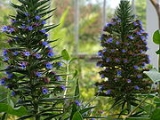
Echium pininana
Encyclopedia
Echium pininana, also called Tree Echium, Pine echium and Giant Viper's bugloss, is a plant, native to La Palma
in the Canary Islands
, that is now cultivated in gardens in Britain and Ireland. Its native habitat is laurel
forests, where it is now endangered through habitat loss.
E. pininana is a biennial
or triennial, showing little more than leaf in the first year, but subsequently produces a dense, 4 metre high (potentially) flower spike that carries a dense mass of leaves and small blue flowers.
The recommendation is that the plant is suited for the southern maritime counties of England. There are, however, reports of successful cultivation in the English Midlands
and Yorkshire
, albeit in favourable locations. Specimens are also grown in Dublin gardens and in the Irish National Botanic Gardens
at Glasnevin
. Although E. pininana is half-hardy in Britain and Ireland, it will self-seed to form clusters of plants, and it's suggested that by natural selection
a hardier variety will emerge.
La Palma
La Palma is the most north-westerly of the Canary Islands. La Palma has an area of 706 km2 making it the fifth largest of the seven main Canary Islands...
in the Canary Islands
Canary Islands
The Canary Islands , also known as the Canaries , is a Spanish archipelago located just off the northwest coast of mainland Africa, 100 km west of the border between Morocco and the Western Sahara. The Canaries are a Spanish autonomous community and an outermost region of the European Union...
, that is now cultivated in gardens in Britain and Ireland. Its native habitat is laurel
Laurus azorica
Laurus azorica is a species of plant in the Lauraceae family, related to laurus nobilis. It is a member of the genus Laurus and is commonly known as Azores Laurel. Laurus is a genus of evergreen trees belonging to the Laurel family, Lauraceae...
forests, where it is now endangered through habitat loss.
E. pininana is a biennial
Biennial plant
A biennial plant is a flowering plant that takes two years to complete its biological lifecycle. In the first year the plant grows leaves, stems, and roots , then it enters a period of dormancy over the colder months. Usually the stem remains very short and the leaves are low to the ground, forming...
or triennial, showing little more than leaf in the first year, but subsequently produces a dense, 4 metre high (potentially) flower spike that carries a dense mass of leaves and small blue flowers.
The recommendation is that the plant is suited for the southern maritime counties of England. There are, however, reports of successful cultivation in the English Midlands
English Midlands
The Midlands, or the English Midlands, is the traditional name for the area comprising central England that broadly corresponds to the early medieval Kingdom of Mercia. It borders Southern England, Northern England, East Anglia and Wales. Its largest city is Birmingham, and it was an important...
and Yorkshire
Yorkshire
Yorkshire is a historic county of northern England and the largest in the United Kingdom. Because of its great size in comparison to other English counties, functions have been increasingly undertaken over time by its subdivisions, which have also been subject to periodic reform...
, albeit in favourable locations. Specimens are also grown in Dublin gardens and in the Irish National Botanic Gardens
Irish National Botanic Gardens
The National Botanic Gardens are located in Glasnevin, 5 km north-west of Dublin city centre, Ireland...
at Glasnevin
Glasnevin
Glasnevin is a largely residential neighbourhood of Dublin, Ireland.-Geography:A mainly residential neighbourhood, it is located on the Northside of the city of Dublin . It was originally established on the northern bank of the River Tolka...
. Although E. pininana is half-hardy in Britain and Ireland, it will self-seed to form clusters of plants, and it's suggested that by natural selection
Natural selection
Natural selection is the nonrandom process by which biologic traits become either more or less common in a population as a function of differential reproduction of their bearers. It is a key mechanism of evolution....
a hardier variety will emerge.

